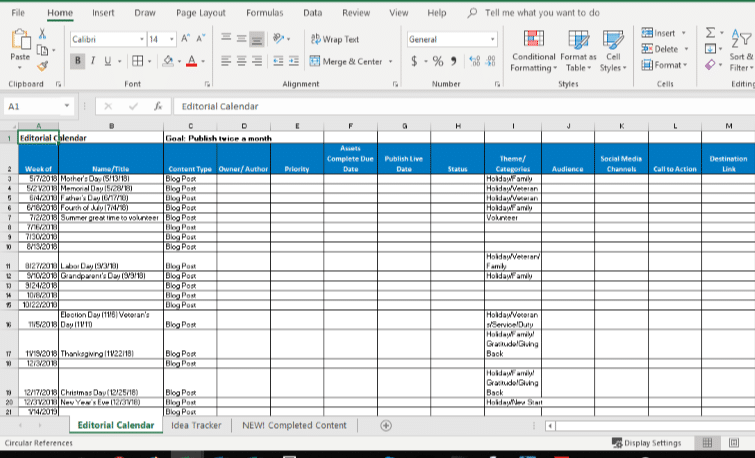Designing an Editorial Calendar You Can Actually Stick With – Part 1
May 8, 2019
Are you new to content creation? Having trouble keeping tabs on projects with multiple deadlines and lots of moving parts? Still looking for a good way to organize all your projects?
Designing an easy-to-use, effective editorial calendar is the key to creating consistent, successful content for yourself, your business, or your clients. It might also be the key to keeping your sanity in the process!
What is an Editorial Calendar and Why Do You Need One?
An editorial calendar establishes what projects need to be completed, outlines the workflow or tasks of each project, and helps you track the progress of those projects.
Editorial calendars have been used in the publishing industry for years to help magazine and book editors stay on top of their projects and deadlines. When you or your clients have an online presence and social media platform, an editorial calendar can help you create, publish, and track ongoing content.
Getting Started: The Main Parts of an Editorial Calendar
An editorial calendar can be as detailed as you need it to be. Some editors and project managers prefer to focus on the big-picture stuff like topics and deadlines. Others track projects down to the tiniest details, keeping tabs on things like keywords, audience profiles, click-through rates, social media shares, and more. Regardless of the level of detail and what format or program you use, there are seven key parts to an effective editorial calendar:
- The name of the project to be completed.
- The type of project, whether a social media post, blog, magazine article, book, etc.
- The purpose of the project (inform, announce, get sales, get leads, entertain).
- Tasks involved in the project and who is responsible for those tasks
- Where the content will be used, sent, or published.
- Deadlines for both project completion and publishing.
- Estimated time for each project and each project task.
Once you have the basic parts of your editorial calendar, you can expand on them as needed. The idea is to create the best calendar for you, one that is fluid so you can grow it as your content needs and projects grow. Need inspiration? You can click here to see some examples.

Creating and Using an Effective Editorial Calendar
The most effective editorial calendars clearly organize the tasks and timing of multiple projects in one easy-to-use tool. It also tracks the flow of each individual project to see progress and completion of the work at hand.
Use these eight time-tested strategies for getting your editorial calendar right from the start:
1. Use one calendar for all content projects.
No matter how many or what types of projects you are trying to manage, or if you have multiple people involved, use only one editorial calendar to track it. Keeping everything in one easy-to see calendar means you’re less likely to miss a deadline or overextend yourself or your staff. Using one editorial calendar also makes it easier to update and revise as needed.
2. Identify outside influences that may impact your calendar.

If you’re submitting content to an outside publication, you’ll make sure that your editorial calendar aligns with theirs. Depending on your company’s industry or area of expertise, your editorial calendar may be affected by current events, conferences and tradeshows, sales goals, product launches, and more. Make sure to identify these potential sources of conflict and adjust your schedule accordingly.
3. Plan your work, work your plan.
An editorial calendar should show your content plan as a whole, with an emphasis on when it needs to be done and who is in charge of doing it.
From there, break down each project further, showing every task involved from start to finish. This will help you allow enough time to complete the work involved with each task.
In most cases, each individual project’s tasks will include things like creating the topic idea, assigning the content piece, research, interviews, outline, draft, editing, photos, links and credits, approval of writing, proofing, and publishing.
4. Plan for the unexpected.
If you can, keep blocks of unscheduled time to add projects in or move them around as needed. The calendar should be a clear working plan but one that also allows for changes you may need to make in your projects and workflow.
5. Add key information.
Add to your calendar as you become more comfortable and consistent with using it. In addition to including basic information, you can start to add more details like keywords, audience, the number of social media shares, click-through rates, original publishing dates, how often the content was published and where, and spin-off ideas from the original content.
6. Decide how far ahead to plan.
Some content plans encompass a whole year while some may only go six months out. Ultimately, you decide what is appropriate for your goals. Going too far out in advance, however, can be overwhelming, especially if this is your first time using a content plan. Smaller timespans may be easier to stick to at first.
7. Develop a system.
Whether you use a spreadsheet, a calendar program, or a good, old-fashioned paper planner, it’s important that you have a way to easily identify the different elements of each project.
Create multiple tabs or areas on the single calendar based on the type of project, timing, or person assigned to the task.
Use color to identify projects, assigned people, timing, or tasks. Create notifiers or alarms so tasks don’t go missed. Flag or highlight important notes that your team can see.
8. Share and protect.
Make sure that your calendar is available to everyone on your team at all times – and that everyone is aware of important updates and changes.

Of course, there are risks to allowing everyone to access and update the calendar. It’s a good idea to take some steps to safeguard against accidental deletions or changes. Spreadsheets and other programs will allow for certain fields to be locked and still give others access and updating abilities. Allow for others to update their progress and make notes on the calendar but protect all the main fields such as headers, categories, critical projects, and firm deadlines.
The Next Step:
Now that you know how to create an effective editorial calendar that meets your needs, check out part two of this series to learn about the common pitfalls you should avoid when designing your calendar. You’ll also learn about some of the tools available to help you create this critical document for your content plan.






























